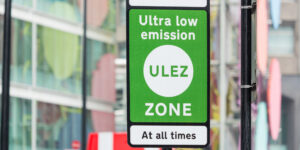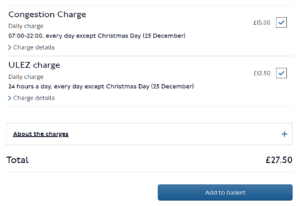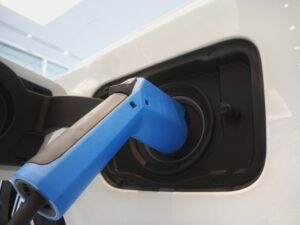
Last updated: November 2021
You may have heard the terms CAZ, LEZ, and ULEZ floating around a lot over the past few years as more and more of the UK’s major cities put green zones into force. However, understanding the differences between each zone and what they actually mean is a little more challenging.
We’re here to break it down and make understanding these abstract terms more palatable.
CAZ, LEZ, and ULEZ are all abbreviations of the low and zero-emission zones that are in force around the UK.
The key aim of these zones is to improve the health and wellbeing of residents and workers in our cities, as they often suffer from poor air quality and above-average toxicity.
Much of the pollution comes from older cars, bikes, vans, and trucks that emit greater amounts of Nitrogen Dioxide (NO2), Sulphur Dioxide (SO2), and Particulate Matter (PM) than their more eco-friendly alternatives.
Therefore, to cut down on these particulates in the air from fossil fuel vehicles, councils have put in the aforementioned ‘green zones’ across the country in order to encourage walking, the use of push-bikes, public transport, or low and zero-emission vehicles.
To make matters slightly more confusing, the CAZ, LEZ, and ULEZ schemes are all different and, despite all being enforced by the government, do not always interlink. Each zone has its own rules that apply.
Keep reading to find out what each zone means, where they’re located, and the restrictions that apply for personal and commercial vehicles.

Location: London (find map here)
Vehicles exempt: Euro 6 HGV’s, buses and coaches; Euro 6 diesel cars/vans; Euro 4 petrol cars and all hybrids, PHEVs and electric cars. As for LPG conversions, it depends on the individual model and engine, so it’s important to check with TfL first. These vehicles are allowed in the ULEZ zone without charge.
How does it work? Transport for London will enforce the ULEZ area with ANPR (Automatic Number Plate Recognition) cameras.
When any driver enters the ULEZ area, their number plate will be read upon entry and this will be cross-referenced with the system.
How much does it cost for non-exempt vehicles? For HGVs (over 3.5 tonnes) it costs £100 – £300 per day for a non-compliant truck to enter the ULEZ. For non-compliant cars, it costs £12. This is on top of the £15 congestion charge.
How do I pay? You can pay for the charges in advance (or within 72 hours) on the ‘Pay to Drive in London’ page on the Transport for London (TfL) website.
The page will look something like this:

If your vehicle is compliant, the ULEZ charge section will state ‘This vehicle meets or is exempt from the ULEZ standards’ and you won’t be able to select it.
What is the penalty? If you don’t pay the ULEZ charges within 72 hours, you will receive a PCN for up to £160 for cars, or up to £1000 for a truck.
More Information:
ULEZ stands for Ultra Low Emission Zone, which is situated in London.
The ULEZ came into force in April 2019 after a recognition that illegal levels of Nitrogen Dioxide (NO2) and Particulate Matter (PM) existed within the capital and contributed to the ill health of some of London’s most vulnerable people.
A report four months after its introduction found that around 13,500 fewer polluting cars were being driven into central London every day, compared with six months earlier
The ULEZ began by covering the red area of this map, but as of the 25th of October 2021, it expanded to the whole of the blue area.

For specific locations, you can use the postcode tool on TfL’s website here: https://tfl.gov.uk/modes/driving/ultra-low-emission-zone/ulez-expansion.
The ULEZ operates 24 hours a day, 7 days a week, every day of the year (except Christmas day).
Location: Greater London (find map here)
Vehicles exempt: The LEZ applies to diesel HGVs, trucks, heavy vans, buses (including minibusses and coaches), and other specialist heavy vehicles. Some light 4x4s and pickups registered new before 1st January 2002 also have to pay the LEZ. Nearly all other vehicles are exempt, but you can double-check this on the TfL website here.
How does it work? There are no barriers or toll booths within the LEZ. Instead, cameras will read your number plate as you drive within the LEZ and check it against a database of registered vehicles.
How much does it cost for non-exempt vehicles? Between £100 – £300
How do I pay? The same way as you pay for ULEZ, via the ‘Pay to Drive in London’ page on the TfL website.
What is the penalty? If you don’t pay the LEZ charges within 72 hours, you will receive a PCN between £500 – £2000 depending on the vehicle.
More information:
The Low Emission Zone (LEZ) operates to encourage the most polluting heavy diesel vehicles driving in London to become cleaner. The LEZ covers most of Greater London and is in operation 24 hours a day, every day of the year.
The LEZ is separate from the aforementioned Ultra Low Emission Zone (ULEZ) which is in place in central London.
There are more LEZ zones around the country, but these only currently affect buses. This includes cities such as Glasgow (as of 2018), Brighton (as of 2015), Norwich (as of 2007) amongst others.

Location: Bath (find map here), Birmingham (find map here), and Portsmouth (map here).
How does it work? There are 4 types of Clean Air Zones, Class A to D. Please see the table below to find out which vehicles are affected by the CAZ.
| Class | Vehicle type |
| A | Buses, coaches, taxis, private hire vehicles |
| B | Buses, coaches, taxis, private hire vehicles, heavy goods vehicles |
| C | Buses, coaches, taxis, private hire vehicles, heavy goods vehicles, vans, minibusses |
| D | Buses, coaches, taxis, private hire vehicles, heavy goods vehicles, vans, minibusses, cars, the local authority has the option to include motorcycles |
Bath is Class C, Birmingham is Class D, and Portsmouth is Class B.
Vehicles exempt:
Each vehicle type has a minimum emission standard. You can find your vehicle’s emission standard in your vehicle logbook or from your vehicle manufacturer.
To avoid being charged in a Clean Air Zone, your vehicle must meet the following minimum standard:
| Vehicle type | Clean Air Zone minimum standard |
| Buses, coaches, heavy goods vehicles | Euro VI |
| Vans, minibuses, taxis, private hire vehicles, cars | Euro 6 (diesel) and Euro 4 (petrol) |
| Motorcycles | Euro 3 |
How much does it cost for a non-exempt vehicle? The CAZ in Bath costs £9 for most vehicles and larger vehicles such as lorries or buses need to pay the higher charge of £100. The Birmingham CAZ is slightly cheaper, at £8 for cars and £50 for buses and lorries. The Portsmouth CAZ charges £10 for cars and vans, and £50 for buses and lorries.
How do I pay?
Payment must be made via the Government’s online payment system or by calling the National Contact Centre on 0300 029 8888 (8am to 4:30pm) either:
What is the penalty?
If you do not pay during the allocated 13-day payment window you will be subject to a minimum PCN of £120.
More Information:
As a continued part of the government plans to improve air quality in some of the UK’s busiest cities, the new Clean Air Zone was introduced in 2021.
The first two cities to introduce CAZs are Bath and Birmingham. However, other towns and cities in England, Wales, and Scotland are testing the idea, and Portsmouth will soon be joining the bandwagon.
Much like the ULEZ charge in London, the two cities that are introducing the CAZ charge plan to run these zone 24 hours a day, 365 days a year.
You can find out more about the CAZ charge on our new CAZ Checker site and check your vehicle meets the CAZ requirements.

You may have also noticed ULEV signs in some of Nottingham’s bus lanes. This stands for Ultra Low Emission Vehicles, which are now allowed in these lanes any time of the day.
So far, ULEV lanes are only being tested in Nottingham, but Bedford and London have also have registered their interest in incorporating ULEV lanes into their cities.
Cities planning on introducing CAZ or LEZ zones in 2022:
Now COP26 has been and gone, new targets have been set by the government. Therefore, we may well see a rise in clean air zones across the country in the coming years. Therefore, it’s best to stay ahead of the game if possible.
If you are interested in learning more about how you can make your commercial vehicle fleet of trucks and vans low or zero-emission, please feel free to get in touch on zero@alltruckplc.co.uk quoting “zero” and we will send you an information pack. Or feel free to reach out to us on Facebook or LinkedIn.